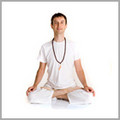 ‘Asana’ (posture) means staying or abiding. Asana is one way in which a person can experience the unity of body and mind. Asana is defined as that which is comfortable and easy, as well as firm. In the west, asana is called “posture”. Yogic postures (asanas) are prescribed for the purpose of comfort and firmness during meditation and the practice of pranayama. An upright seated posture in which one can sit with comfort and no need to move is ideal for meditation.
‘Asana’ (posture) means staying or abiding. Asana is one way in which a person can experience the unity of body and mind. Asana is defined as that which is comfortable and easy, as well as firm. In the west, asana is called “posture”. Yogic postures (asanas) are prescribed for the purpose of comfort and firmness during meditation and the practice of pranayama. An upright seated posture in which one can sit with comfort and no need to move is ideal for meditation.
Asana is a dynamic position, in which the practitioner is perfectly poised between activity and non-activity. There is a corresponding mental balance between movement and stillness. Patanjali teaches that each posture reflects a mental attitude; whether that attitude is one of surrender, as in a forward-bending asana, or the strengthening of the will, through backward-bending postures, or the creation of a physical prayer with the body, as in the practice of Padmasana, the well-known lotus posture.
The asanas are yoga postures. Traditionally asanas are positions which are held still for a certain amount of time – from a few seconds to a few hours! Usually the asanas will be held for an average of two to three minutes.
Besides being held steadily they should also be held comfortably. No pain should be experienced while holding the posture or in the hours or days that follow.
 Asanas are an integral part of Shaktiananda Yoga. They are physical postures with a distinct form and shape that involve the application of exact stretches, counter stretches and resistances. There are cycles of postures that give a variety of different effects on the body: energizing, stimulating and calming.
Asanas are an integral part of Shaktiananda Yoga. They are physical postures with a distinct form and shape that involve the application of exact stretches, counter stretches and resistances. There are cycles of postures that give a variety of different effects on the body: energizing, stimulating and calming.
Asanas are connected by vinyasa which is a form linking movements that help maintain a high body heat. This constant controlled movement creates a heightened energy level, toning the body into a high level of fitness, and producing remarkable strength with regular practice.
Asanas have a profound effect on the body. The body is oxygenated, decongested, and rested. Circulation, respiration, heart performance, and muscle tone can be improved. Specific areas on the body can be worked on like the joints, liver, kidneys, or the heart.
Practice brings benefits: good balance, agility, and stamina. Many ailments and chronic disorders can be improved with regular asana practice. Regular asana practice is a training regimen that creates a vigorous body, well functioning organs, and an alert mind.
 The Yoga Sutras of Patanjali say that when the asanas are mastered the individual is more able to handle opposites and learn to adapt. Asana practice improves the ability to stand with ease, sit comfortably, or to cope with different demands. If we want to practice pranayama and meditation, we have to be able to sit comfortably erect for a period of time.
The Yoga Sutras of Patanjali say that when the asanas are mastered the individual is more able to handle opposites and learn to adapt. Asana practice improves the ability to stand with ease, sit comfortably, or to cope with different demands. If we want to practice pranayama and meditation, we have to be able to sit comfortably erect for a period of time.
Asanas help us focus on the breath rather than the body during pranayama practice. If we can sit comfortably and effortlessly erect there is nothing to distract us from our concentration on the breath and experience a deep meditation.
Once the mental attitude has been created, it can then be spontaneously expressed as an asana; if one takes on the external form of an internal attitude, soon that attitude moves through body into mind, thus creating it there. Whichever way one works, the results are the same. Asana is thus both a preparation for meditation and a meditation sufficient in and of itself.
Another advantage of asana is that it is direct. It can temporarily bring peace and quiet the mind. This quieting encourages the balancing of the mental functions of the individual, since it allows the intuitive aspects of the mind to have free play. This soothing effect on the brain has been verified by EEG data of brain during meditation. It has great healing implications. Patanjali suggests that the asana and the pranayama practices will bring about the desired state of health; the control of breath and bodily posture which will harmonize the flow of energy in the organism, thus creating evolution of the Spirit called Self-realization.
Asanas are an integral part of yoga. They are physical postures with a distinct form and shape that involve the application of exact stretches, counter stretches and resistances. There are cycles of postures that give a variety of different effects on the body: energizing, stimulating and calming.
Asanas are connected by vinyasa which is a form linking movements that help maintain a high body heat. This constant controlled movement creates a heightened energy level, toning the body into a high level of fitness, and producing remarkable strength with regular practice.
Asanas have a profound effect on the body. The body is oxygenated, decongested, and rested. Circulation, respiration, heart performance, and muscle tone can be improved. Specific areas on the body can be worked on like the joints, liver, kidneys, or the heart.
Practice brings benefits: good balance, agility, and stamina. Many ailments and chronic disorders can be improved with regular asana practice. ShaktianandaYoga practice is a training regimen that creates a vigorous body, well functioning organs, and an alert mind.
> Formula

